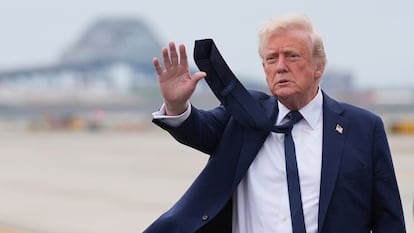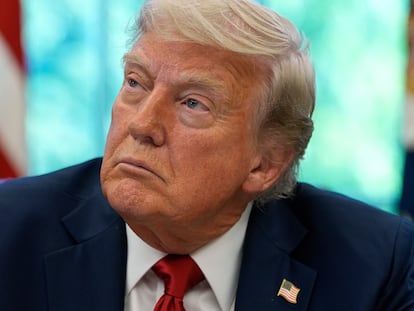Chapter 2: Communicating for the show
In this second installment of the ‘Trump Observatory’, political consultant Antoni Gutiérrez-Rubí analyzes how the Republican president has upped the showmanship in his second term

Trump and the White House reality show
Scene 1: Donald Trump raises his fist and shouts “Fight, fight, fight!” seconds after being the target of an assassination attempt.
Scene 2: The U.S. president and vice president have a tense discussion with Ukrainian leader Volodymyr Zelenskiy in the Oval Office, and Trump’s first reaction is to say that the situation will be great for television.
Scene 3: The U.S. president attends a NASCAR race and first flies over the track in his plane and then drives around it in his presidential car.
An entire book could be written with more examples like these. Trump cemented his popularity through television. The Apprentice, the reality show he starred in for 14 seasons until 2015, established his image and essentially became his presidential pre-campaign before the 2016 elections. That’s why he’s obsessed with ratings and why he knows how to exploit every opportunity to attract attention and make his messages go viral. Every public appearance is seen as a potential show.
In his second term, the U.S. president has upped the showmanship. Along with the “flood the zone” strategy, which we analyzed in the first installment of the Trump Observatory, he dominates the minds and hearts of a large portion of the population through carefully designed, almost theatrical performances. Each one is a display of his power and heroism.
The mediatization of politics is nothing new. It has been on the rise since Arthur Miller, in his 2001 lecture “On Politics and the Art of Acting,” warned that we are surrounded by so many deliberately falsified or exaggerated performances that it is becoming increasingly difficult to identify reality. But Trump has now gone a step further. In his first 90 days in office, he has held an average of at least five media-heavy events per week to position his messages and political narrative.
In his famous book, Storytelling: Bewitching the Modern Mind, Chris Salmon warned that new information systems help to blur the lines between reality and fiction. The art of governing is transformed into the art of staging. Reality is no longer important, and its place is taken by communication in order to capture attention and gain support. It doesn’t matter how you govern or the actual results; what matters is the story that you tell. Master the narrative in order to master politics.
Below, we analyze in greater detail, and with examples, six ways in which Trump and his team apply the strategy of theatricality:
1. Meetings and events with celebrities
Since Trump returned to the White House, celebrities of all kinds have paraded through his office. The president has also attended some of the most popular sporting events in the United States. For example, he was the first president to attend a Super Bowl live. Trump knows that his mere presence at these types of events guarantees virality on social media and airtime on the news. It also helps him connect with the less politicized electorate.
Examples:
2. Signing laws and executive orders
Government measures cease to be mere public policies and become a spectacle with Trump as the protagonist. When he signed the decree eliminating the Department of Education, he did so at a school desk surrounded by students in a makeshift classroom. To sign an order against the participation of transgender athletes in women’s sports, he surrounded himself with female athletes. To formalize the renaming of the Gulf of Mexico, he took advantage of Air Force One’s flight over the area and had the plane’s captain announce it over the sound system. The president’s own signature and the markers he uses take on a central role in a kind of new graphological populism.
And the content of what he signs is often not really important. The president publicly warns of a major threat that he is about to correct with the approved measure. He presents himself as the hero, even if days later he himself may have to rectify, or a judge might block it. This has already happened with the “Liberation Day” tariffs and various executive orders.
Examples:
3. Receiving foreign leaders
Twelve foreign leaders have visited Trump at the White House, and the same script is repeated with each one. They are shown entering the White House, then conversing with Trump in the Oval Office, and finally holding a press conference. The goal is to show his power; they come from outside to pay tribute to him. As Philippe Moreau writes, any leader who enters his office is entering a television set. The only one who didn’t fully assume his role was Zelenskiy. He didn’t bow his head as intended, and the result was his expulsion from the White House.
Examples:
4. Cabinet meetings
The meetings with members of his administration are not intended to analyze the country’s situation and make decisions. Instead, they are also television segments highlighting the administration’s achievements and how the secretaries of the various departments are working to advance the leader’s agenda. In a recent meeting, Trump asked each of them to publicly account to the public for what they had done in their first months in office.
Examples:
𝐌𝐚𝐣𝐨𝐫 𝐀𝐧𝐧𝐨𝐮𝐧𝐜𝐞𝐦𝐞𝐧𝐭𝐬 𝐨𝐮𝐭 𝐨𝐟 𝐭𝐡𝐞 𝐂𝐚𝐛𝐢𝐧𝐞𝐭 𝐌𝐞𝐞𝐭𝐢𝐧𝐠 𝐓𝐨𝐝𝐚𝐲.
— Anna Matson (@AnnaRMatson) April 10, 2025
One by one, Cabinet members reported directly to the people.
Here is a recap by department and I’m not joking when I say the best are towards the end 🧵 pic.twitter.com/xyf3IF2ByF
5. Trips
Trump tends to travel between the White House and his Mar-a-Lago residence; these are his preferred locations. However, he made two trips early in his administration to cement his hero-savior narrative. He went to California days after the deadly wildfires in Los Angeles and to the areas in North Carolina hit by Hurricane Helene in September. In both places, he repeated the same message: the Biden administration had abandoned its citizens, but that would change with him in charge. One of his measures wasted 2,200 gallons of water in California. But the important thing isn’t the result; it’s the show.
Examples:
6. The supporting actors
Trump is undoubtedly the star of the show, but he’s not the only actor in it. He’s made sure of this by making cabinet selections that take each member’s ability to play their role into account. It’s no surprise, then, that several of them have considerable television experience.
His vice president, JD Vance, became famous for an autobiographical book that was later adapted for the big screen via Netflix. In April, an event was held at the White House to celebrate his mother’s 10 years of staying sober.
Another figure who has stood out for her theatrical abilities is Secretary of Homeland Security Kristi Noem. She recorded herself setting trash on fire with a flamethrower, toured the border dressed as a cowgirl, and sent a message to immigrants with prisoners in the background warning them not to enter the United States illegally.
Examples:
Got the chance to fly a C-130 out of our U.S. Coast Guard base in Kodiak, Alaska. Air Station Kodiak is essential to our mission success for reconnaissance and search & rescue in Alaska and the Arctic. pic.twitter.com/tbvQDSmj0o
— Kristi Noem (@KristiNoem) March 17, 2025
To find out more
Books:
- Arthur Miller: Politics and the Art of Acting
- Chris Salmon: Storytelling: Bewitching the Modern Mind
- Luis Arroyo: Political power on stage
- James Poniewozik: Audience of One: Television, Donald Trump, and the Politics of Illusion
- Guy Debord: The Society of the Spectacle
Articles:
- Philippe Moreau: How to understand Donald Trump
- Megan Barber: Trump Is Breaking the Fourth Wall
- Maxim Voronov, Madeline Toubiana and Trish Ruebotton: How Reality TV Helps Explain Trump’s Success
- Ravi Agrawal: The Perils of a Reality TV Presidency
- John Street: What is Donald Trump? Forms of ‘Celebrity’ in Celebrity Politics
Videos:
- NBC News: 2000s: ‘Apprentice’ Helps Donald Trump Finally Launches A White House Bid
- The Atlantic: How the apprentice manufactured Trump
Podcast:
Sign up for our weekly newsletter to get more English-language news coverage from EL PAÍS USA Edition
Tu suscripción se está usando en otro dispositivo
¿Quieres añadir otro usuario a tu suscripción?
Si continúas leyendo en este dispositivo, no se podrá leer en el otro.
FlechaTu suscripción se está usando en otro dispositivo y solo puedes acceder a EL PAÍS desde un dispositivo a la vez.
Si quieres compartir tu cuenta, cambia tu suscripción a la modalidad Premium, así podrás añadir otro usuario. Cada uno accederá con su propia cuenta de email, lo que os permitirá personalizar vuestra experiencia en EL PAÍS.
¿Tienes una suscripción de empresa? Accede aquí para contratar más cuentas.
En el caso de no saber quién está usando tu cuenta, te recomendamos cambiar tu contraseña aquí.
Si decides continuar compartiendo tu cuenta, este mensaje se mostrará en tu dispositivo y en el de la otra persona que está usando tu cuenta de forma indefinida, afectando a tu experiencia de lectura. Puedes consultar aquí los términos y condiciones de la suscripción digital.
More information
Archived In
Últimas noticias
The metaverse, four years later: Is it finished or just at a standstill?
$3,000 and a plane ticket: The United States increases incentives for migrants to self-deport before the end of the year
Charles Dubouloz, mountaineering star, retires at 36 with a farewell tour inspired by Walter Bonatti
From the White House to diplomatic gifts: Lego wins over adult fans, brick by brick
Most viewed
- The low-cost creative revolution: How technology is making art accessible to everyone
- Christian Louboutin: ‘Young people don’t want to be like their parents. And if their parents wear sneakers, they’re going to look for something else’
- All the effects of gentrification in one corner of Mexico’s Colonia Roma
- Christmas loses its festive spirit: ICE fears cast shadow over religious celebrations
- Liset Menéndez de la Prida, neuroscientist: ‘It’s not normal to constantly seek pleasure; it’s important to be bored, to be calm’










































